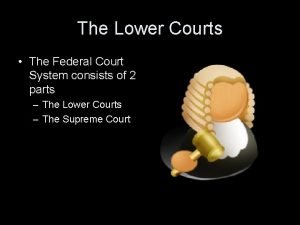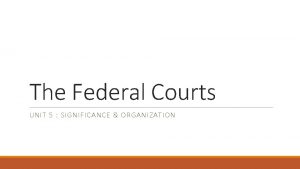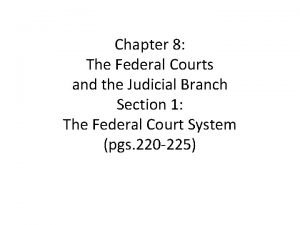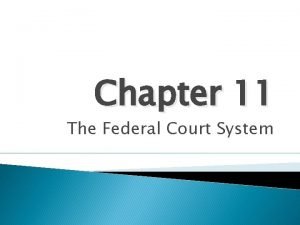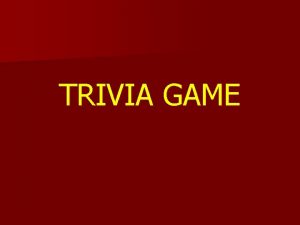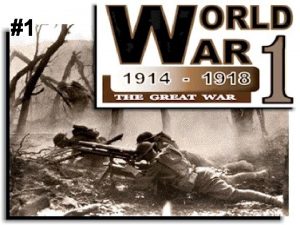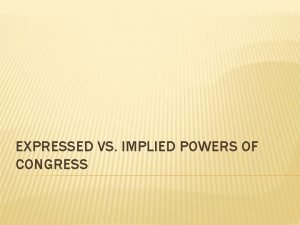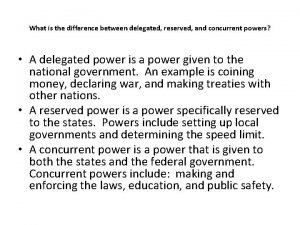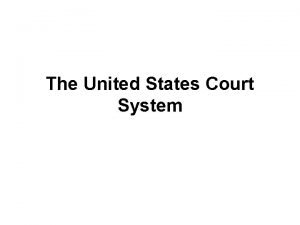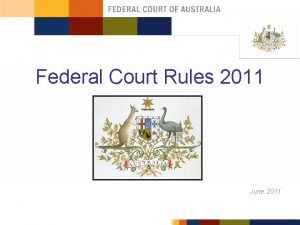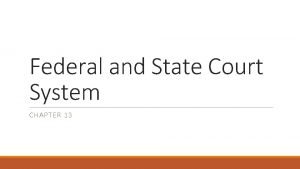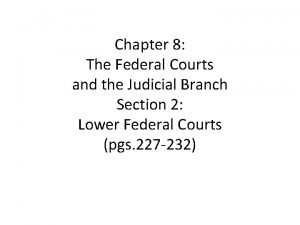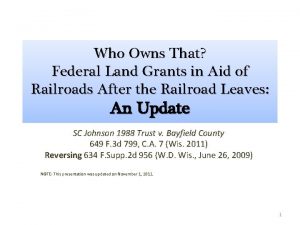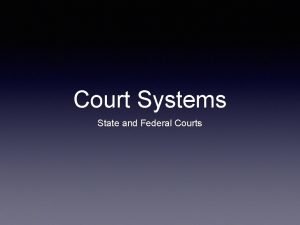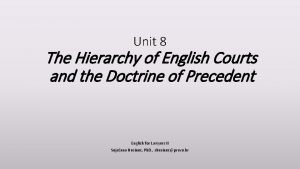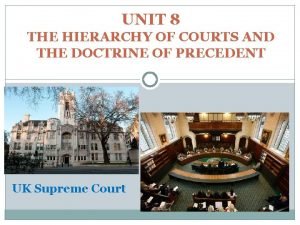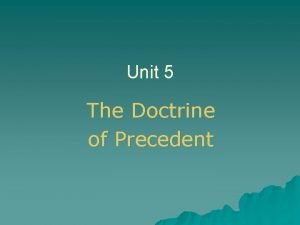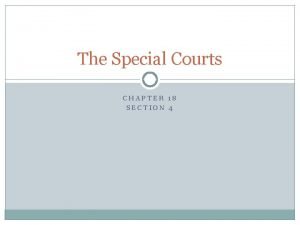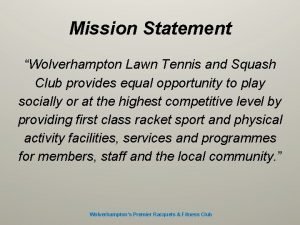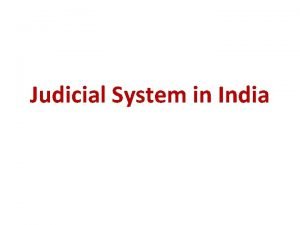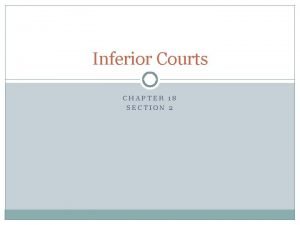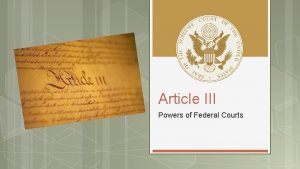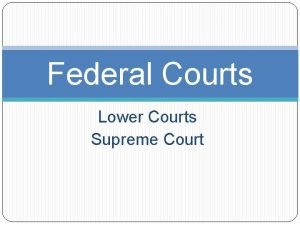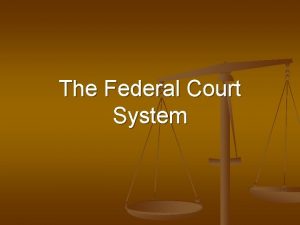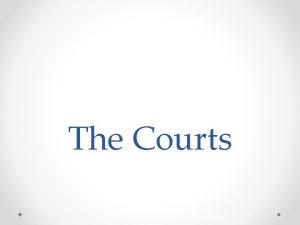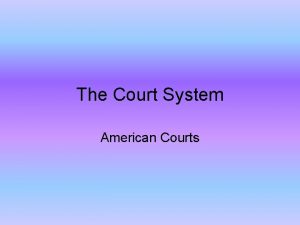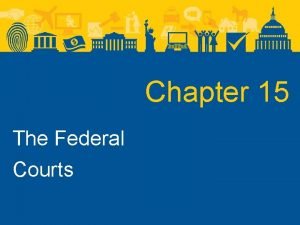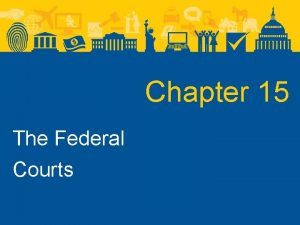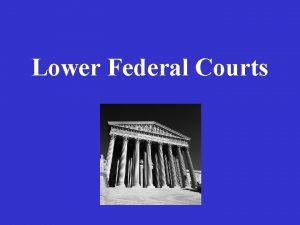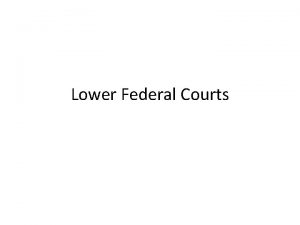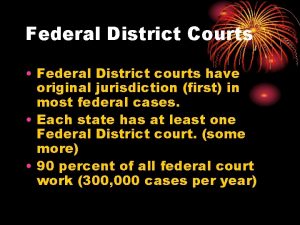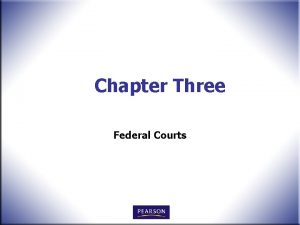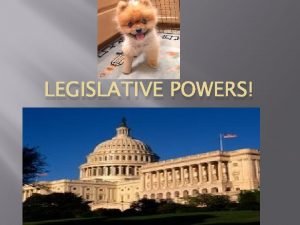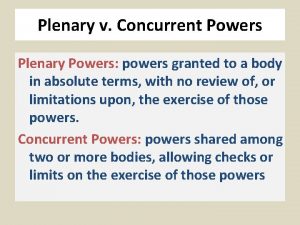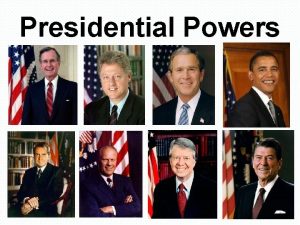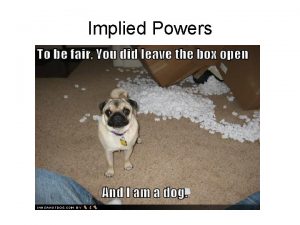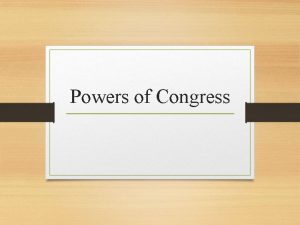Federal Court System Powers of Federal Courts U

























- Slides: 25

Federal Court System

Powers of Federal Courts U. S. has a dual court system (Federal & State) n State courts have jurisdiction over state laws n Federal courts have jurisdiction over federal laws n

Federal Court Jurisdiction If certain people or groups are involved, then federal court has jurisdiction: n Ambassadors of foreign countries n Two or more state governments n U. S. Govt. or one of its agencies n Citizens who are residents of different states n

Concurrent Jurisdiction Some instances where both the state and federal court has jurisdiction: known as concurrent jurisdiction n Example: People from same state but suit involves over $75, 000; people can choose where case goes n

Original Jurisdiction Where the case originates; where it is initially tried n Trial court and district courts n

Appellate Jurisdiction If a person loses a trial, they may appeal. n Courts that have the authority to hear appeals. n



Supreme Court Justices Made up of 9 Justices n 1 Chief Justice n 8 Associate Justices n Receive around $217, 000 n May be impeached and removed n Only one has been impeached, but not removed (Samuel Chase) n

Supreme Court Justices n n John Roberts (Chief Justice-Bush) Samuel Alito (Bush) Antonin Scalia (Reagan) Clarence Thomas (G. H. W. Bush) n n n Stephen Breyer (Clinton) Ruth Bader-Ginsberg (Clinton) David Souter (G. H. W. Bush) (retiring) John Paul Stephens (Ford) Anthony Kennedy (Reagan)

Duties of Justices Main duty is to hear and rule on cases n Decide three things: n Decide which cases to hear n Deciding the case n Determining an explanation of ruling, called an opinion n


How Supreme Court Gets Cases 1) Writ of certiorari- Supreme Court gives orders to send up a case n 2) On Appeal- very few reach it this way, usually must have to deal with federal law n 3) Solicitor General- lawsuit involving the United States n

Selecting Cases Usually reject over 90% of appeals, making lower courts ruling final n Only discuss about 1/3 of writ of certiorari cases n Need 4 of 9 justices to accept a case n

Steps in Deciding Major Case n Submitting Briefs: written statement submitted by lawyers explaining legal arguments, relevant facts, and precedents supporting case

Steps in Deciding Major Case Oral Arguments: allowed 30 minutes to speak; Justices can interrupt and ask questions n Conference: Justices meet to debate case and facts. n Majority must be in agreement; at least 6 must be present; if a tie, then lower court decision stands n

Steps in Deciding Major Case Writing the Opinion: 4 types outlining why they ruled a certain way n Unanimous opinion: all in favor or all against n Majority Opinion: winning side n Concurring Opinion: agreed with ruling, but for different reasons n Dissenting Opinion: disagreed with ruling n

Federal District Courts n Uses two types of juries n Grand Jury- made up of 16 -23 people n n See if there is enough evidence for an indictment (formal charge) Petit Jury- made up of 6 -12 people n The trial jury, hears the evidence, makes a decision on the case

Selection of Federal Judges n n n Party Affiliation: Presidents tend to pick judges who are members of their political party Judicial Philosophy: same political ideologies as President, since they serve for life Senatorial Courtesy: will ask Senators from the state the nominee is from for their opinion


Limits of Supreme Court n n Limits on Types of Issues: don’t deal with foreign policy Limits on Types of Cases: must be brought to trial, be a federal issue, plaintiff must have suffered real harm Limited Control over Agenda: only can take the cases that come to them Lack of Enforcement: have no power to enforce their decisions

Developing Power for Supreme Court Early Precedents: n Court does not seek out cases; must be brought to them n Will only determine cases; won’t just answer legal question without determining case as well n

Marbury vs. Madison Before John Adams left office, appointed several “midnight” judges n Didn’t deliver their appointment, and once Jefferson took office, he refused to deliver them n Marbury sued Sec. of State James Madison for his position n

Marbury vs. Madison Chief Justice John Marshall took the case n Said Marbury’s rights had been violated n However, ruled that the court had been given too much power under Judiciary Act of 1789, and ruled it unconstitutional n Jefferson won case n Supreme Court gain power of judicial review n

John Marshall’s Influence Helped the Supreme Court gain power it has today n Fletcher v. Peck: Courts right to review state laws n Mc. Culloch v. Maryland: helped federal govt. get power from states n Gibbons v. Ogden: broadened meaning of interstate commerce n
 Federal court system structure
Federal court system structure Us federal
Us federal Dual court system answer key pdf
Dual court system answer key pdf What court helps congress exercise its power
What court helps congress exercise its power State courts us
State courts us Is there a basketball court above the supreme court
Is there a basketball court above the supreme court Was the united states on the axis powers or allied powers?
Was the united states on the axis powers or allied powers? List the allied powers and the central powers
List the allied powers and the central powers Expressed powers and implied powers
Expressed powers and implied powers Enumerated powers vs implied powers
Enumerated powers vs implied powers Implied power example
Implied power example How do delegated, reserved, and concurrent powers differ?
How do delegated, reserved, and concurrent powers differ? Informal checks on the president
Informal checks on the president Us circuit court map
Us circuit court map Federal court rules 2011
Federal court rules 2011 Chapter 13 federal and state court systems
Chapter 13 federal and state court systems Federal district court map new york
Federal district court map new york Federal court structure
Federal court structure Federal and state court systems
Federal and state court systems Hierarchy of uk courts
Hierarchy of uk courts Hierarchy of the judicial system
Hierarchy of the judicial system Hierarchy of uk courts
Hierarchy of uk courts Chapter 18 section 4 the special courts
Chapter 18 section 4 the special courts Tennis courts wolverhampton
Tennis courts wolverhampton Judiciary system in india
Judiciary system in india Chapter 18 section 2 the inferior courts
Chapter 18 section 2 the inferior courts
